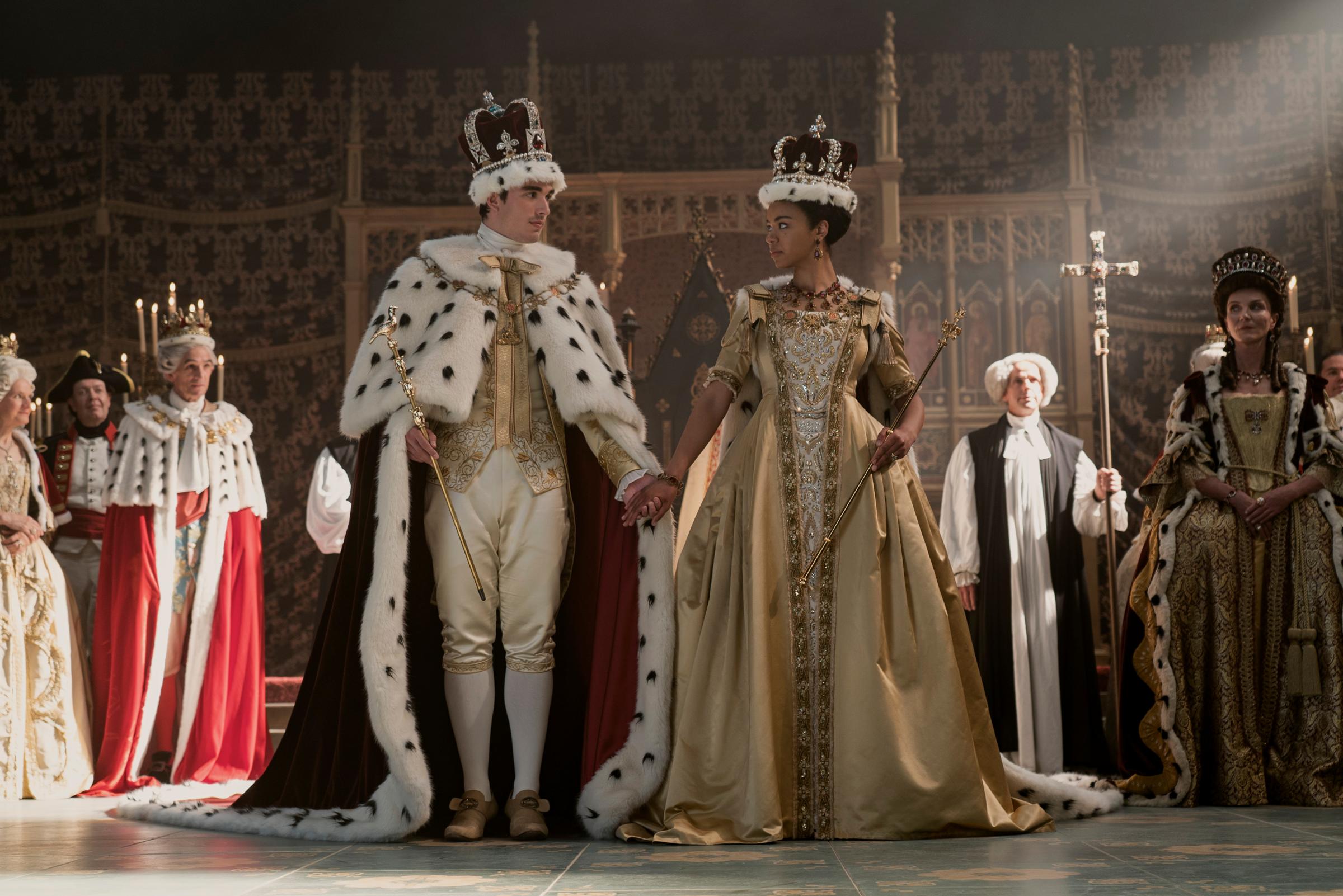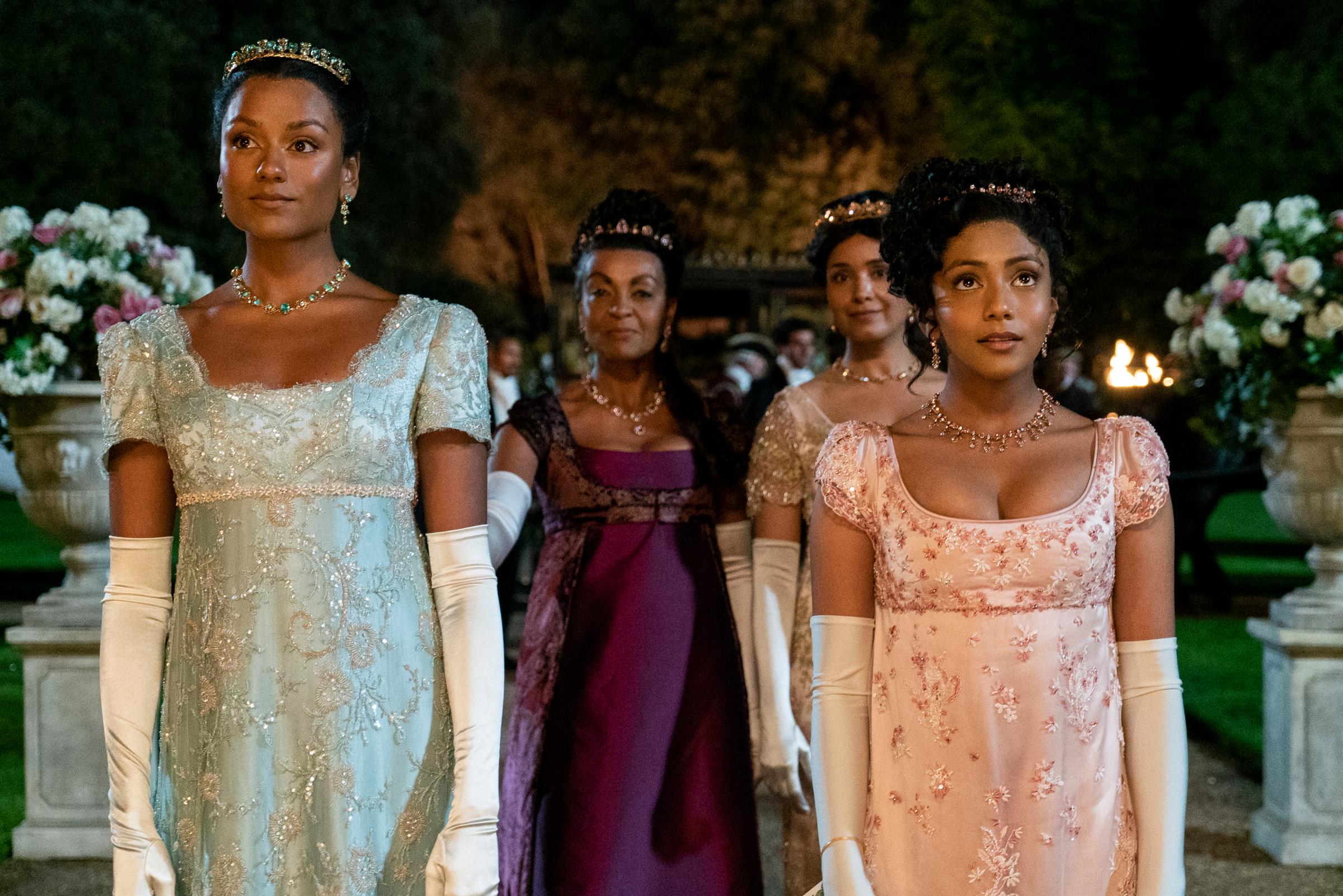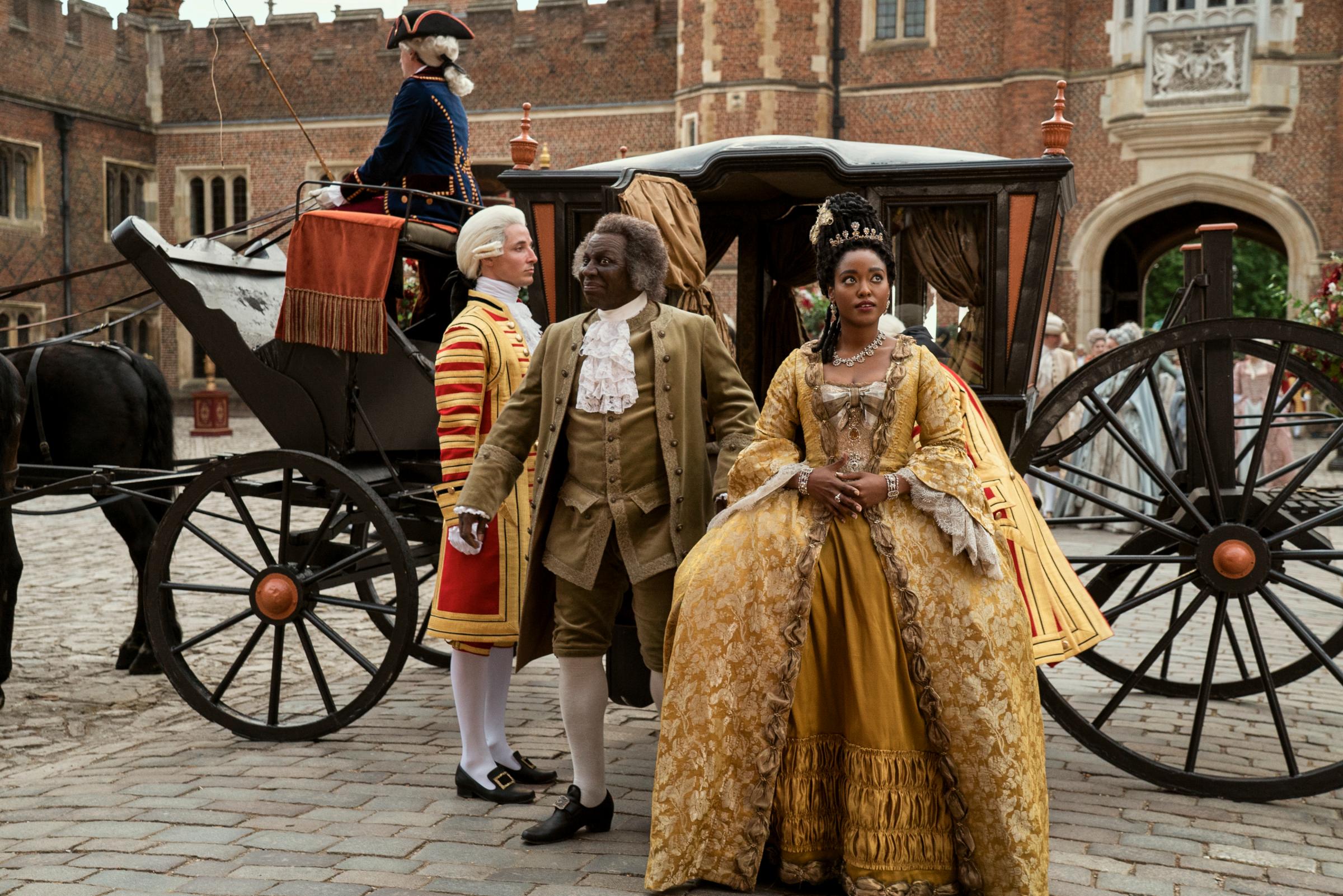If you didn’t know Queen Charlotte: A Bridgerton Story was a Shonda Rhimes show, it wouldn’t take you long to guess as much. Five minutes into the premiere, the eponymous teen (India Amarteifio) is traveling by carriage from her home in Germany to England to wed a king she has never met. When her brother (Tunji Kasim), who arranged this marriage, remarks that she looks as stiff as a statue, Charlotte educates him about her clothing. “Whales died so I could look like this,” she says. “All the finest corsets are whalebone. You would know that if you knew anything. If you ever paid attention, you would also know that the problem with whalebone is that it is rather delicate and also very, very sharp. And, of course, I’m in the height of fashion, so this corset is quite snug. So I give the appearance of a statue—ridiculous to the eye, but that is because I cannot move, and because I must arrive on display, I am forced into a ludicrous gown so stylish that if I move too much, I might be sliced and stabbed to death by my undergarments.”
It’s an unlikely monologue from an 18th-century royal but one that recalls Rhimes’ most indelible heroines. Olivia Pope in Scandal, Annalise Keating in How to Get Away With Murder, Miranda Bailey in Grey’s Anatomy—these women are always pulling back the curtain to reveal, in impassioned speeches, how hard it is to make greatness look easy. Queen Charlotte, a breakout character in Bridgerton, a Shondaland series that was not created by Rhimes and that takes place decades later than this prequel, belongs to this tradition. In writing the young queen’s story to fit her own favorite archetype, Rhimes fixes the biggest problem with Bridgerton: its anachronistic (or alternate-reality) Regency Britain simply doesn’t make sense.

The Bridgerton franchise, with its jewel-toned gowns and string-quartet covers of 21st century pop hits, has never pretended to be historically accurate. As Julie Andrews announces in a preface to the latest installment, in her plummiest Lady Whistledown voice: Queen Charlotte “is not a history lesson. It is fiction inspired by fact. All liberties taken by the author are quite intentional.” Such disclaimers have not preempted criticism from literal-minded history buffs and oversensitive cultural warriors eager to denounce any story that centers non-white characters as “woke.” Of course, the most vocal backlash has been to the franchise’s racial diversity. Its British aristocracy is integrated. In season 1, white noblewoman Daphne Bridgerton (Phoebe Dynevor) marries a Black duke, played by Regé-Jean Page. Season 2 finds her brother (Jonathan Bailey) caught between two half-sisters (Simone Ashley and Charithra Chandran) from India.

Queen Charlotte starts to make sense of this mess. Inspired by the real Charlotte of Mecklenburg-Strelitz, a German duke’s daughter who married King George III in 1761 and who may or may not have had African ancestors, the show makes no attempt to avoid its heroine’s race. Amarteifio—like Golda Rosheuvel, who plays Bridgerton’s older version of Charlotte and also appears in flash-forwards within this series—is of mixed racial heritage. And in Rhimes’ telling, Charlotte’s wedding to George (Corey Mylchreest) brings about a “Great Experiment” in integration that results in those diverse ball scenes we often see in Bridgerton. One beneficiary of this project is Lady Danbury (played by Arsema Thomas as a young woman and Adjoa Andoh in later years), a shrewd Black noblewoman who was marginalized before Charlotte’s arrival and who leverages her relationship with the queen to secure her family’s place in society.
It’s a neat explanation—and one that works well thematically, if not historically. Regardless of where and when they’re set, all stories worth telling have something to say about the time and place in which their creator and audience live; Rhimes’ reimagined 18th century England has much in common with the contemporary U.S. It’s a multicultural society, but one that is in the midst of a painful transformation. While average citizens fall outside the frame (a common complaint about Rhimes shows), all eyes are on an aristocracy that has finally welcomed, or at least allowed, a few people of color into its midst. These characters have power. But they never forget that they need to be smarter and work harder than their white peers, or that some of these peers will always see them as outsiders no matter what they accomplish.

Even the marvelously self-possessed Charlotte worries, when George refuses to spend their wedding night and many subsequent evenings by her side, that something about her fails to measure up to his standards. Later in the season, while sitting for a wedding portrait, she notices that the painter has made her complexion too light. “Paint my skin darker—as it actually is,” Charlotte tells him. “No,” says George’s mother, the Dowager Princess of Wales (Michelle Fairley). “Paint her skin lighter. Pale. His Majesty wants her to glow.” It’s a plausible explanation for the real Charlotte’s appearance in portraits. More than that, it echoes current controversies around the alleged lightening of Black celebrities’ skin on magazine covers as well as Harry and Meghan’s claims that a member of the royal family worried their children would have dark skin.
If Charlotte makes more sense as a contemporary woman of strong will and estimable talents than as a historical queen, that is because Rhimes has given purpose and resonance to what was formerly well-meaning but incoherent anachronism. Like Olivia, Annalise, and the rest of her Shondaland forebears, Charlotte can be understood in part as an avatar for her creator: a person of extraordinary abilities, whose identity as a Black woman doesn’t diminish her power within her sphere of influence so much as it creates complications that would not exist for white men. Rhimes can make a hit TV drama with a Black, female lead, for instance, but someone is bound to call her an “angry Black woman” for doing it. Unlike Bridgerton, Queen Charlotte is grounded in reality. It’s just that the society it captures isn’t Georgian England but our own.





